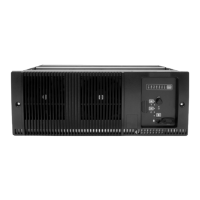50 Installation TB9100/P25 CG/P25 TAG Installation and Operation Manual
© Tait Limited March 2014
4. Press the ‘Enter’ key. A login prompt will appear displaying the base
station’s IP address.
Customizing the Configuration
While the base station is still on the bench, you can configure the settings it
requires. The CTU can help you test its operation. The following steps
provide an overview of the process. For detailed information and assistance,
refer to the CSS Help or manual.
1. Run the CSS software.
2. Check that the CSS PC is connected to the base station via an
Ethernet cable and a hub.
3. On the toolbar, click Connect. The Connections dialog box appears.
4. Click on the appropriate entry in the base station list, and then click
Connect.
5. On the toolbar, click Read to read in the configuration settings on
the connected base station.
6. On the toolbar, click Configure. The navigation tree now gives you
access to the available configuration screens.
7. Make the changes needed.
8. Click “File > Save” to save your changes, and then click Program on
the toolbar to program these changes into the base station.
Notice Make sure that you save the configuration to a file. This pro-
vides a backup in case the configuration information becomes lost or
corrupted.
Recommended CSS Settings for Dual Base Stations
In a dual base station the second base station’s reciter and PA are isolated
from the first base station’s reciter, PA, and PMU. Solid state relays and
control logic on the subrack interconnect board isolate the two base station
communication channels from each other. All other signals remain in
parallel. The relays are controlled by a key press of the base station select
buttons on the control panel.
Note that the fans have power supplied from the relevant PA or PMU
module, with the rotation sensor alarm signal interfaced into the control
panel. This signal is processed via the reciter associated with the PA or
PMU.

